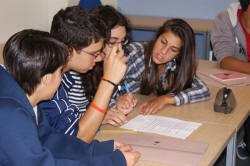Unpacking and explaining the CELTA syllabus and assessment criteria

The CELTA syllabus was last updated in 2018 but has not become
any clearer. It is written by the initiated for the initiated.
What follows is an attempt to translate Cambridge
Assessment English-speak into language comprehensible to normal
people.
The Cambridge specifications have been re-arranged to link the
syllabus to the assessment criteria. Then they have been
translated and linked to other guides on this site (mostly in the
initial-plus training section) to help you meet the criteria.
The following is based on the fifth edition of the Cambridge
Syllabus and Assessment Guidelines, published in February 2018 and available on the Cambridge website
at
https://www.cambridgeenglish.org/teaching-english/teaching-qualifications/celta/about-the-celta-course/.
There is an amended syllabus with temporary changes caused by the
recent Covid19 outbreak but changes are not fundamental to the syllabus.
The syllabus comes in five parts and there is a guide to each on
this site accessible from
the CELTA
index. We will take them one at a time, looking at what
they say, what they mean and how your performance is assessed in
each section. We will also consider how to meet the
criteria to get the best possible grade.
(The sections of the syllabus are variously called 'Areas' and
'Topics'. Don't worry; they mean the same.)
If you have ambitions to get an A-grade on CELTA, this is a good
place to start.
You can click on this diagram to go to the area that interests
you or work your way down the guide area by area.
At any stage, clicking on the
![]() will return you to this
diagram (you will find it on the left at the end of each section).
will return you to this
diagram (you will find it on the left at the end of each section).

The final section of this guide concerns how the criteria are assessed and graded and what the final overall grades for CELTA mean. You can click here to go there now.
All links in the following will open in a new tab so if you want to have a quick look you can and then just shut the page to come back here.
 |
CELTA Syllabus Area 1Learners and teachers, and the teaching and learning context |
There are six sections to this area.
| # | Title | What you need to be able to do | Translation |
| 1 | Cultural, linguistic and educational backgrounds | understand the range of backgrounds and experiences that adult learners bring to their classes | This means being aware of three
major things about learners:
|
| 2 | Motivations for learning English as an adult |
|
|
| 3 | Learning and teaching preferences |
|
|
| 4 | Context for learning and teaching English |
|
|
| 5 | Varieties of English |
|
|
| 6 | Multilingualism and the role of first languages | understand the kinds of language backgrounds that learners may come from (e.g. multilingual/monolingual; different varieties of English) and how a learner’s language background might influence the learning of English | In pre-2018 versions of
the syllabus there was mention of standard and
non-standard varieties of English but this has been
changed to different varieties to reflect that fact
that deciding what is standard or non-standard is an
unnecessary value judgement. This is not a difficult area but requires a little thought:
|
The assessment of Section 1 There are 4 critical assessment criteria and one written assignment which focus on this area. The assessment criteria are: |
|||
| 1a | teaching a class with an awareness of the needs and interests of the learner group | Translation: teach what the learners need to learn, not what they already know or what is not relevant to them. | |
| 1b | teaching a class with an awareness of learning preferences and cultural factors that may affect learning | Translation: be aware of how risk-aversion or expectations of power roles may affect how people function in groups and what their attitude to the teacher's role may be. | |
| 1c | acknowledging, when necessary, learners’ backgrounds and previous learning experiences | Translation: do not talk down to adults, whatever their language ability in English and do not assume that they will be amenable to new and innovative approaches unless you can demonstrate their worth. | |
| 4a | identifying and stating appropriate aims/outcomes for individual lessons | Translation: do not teach what the learners do not need to know or what they cannot yet handle. | |
| The written assignment is entitled Focus on the Learner
and there is
a separate guide to how to write it on this site. Click here to go to the dedicated guide to this section of the syllabus. |
|||
 |
CELTA Syllabus Area 2Language analysis and awareness |
There are seven sections in this area but they are linked to each other.
| # | Title | What you need to be able to do | Translation |
| 1 | Basic concepts and terminology used in ELT to discuss language form and use | understand key terminology used in ELT to talk about language and apply this terminology to planning and teaching | You need to understand the
difference between:
There is also a guide to form, function and meaning which tells you more about language use. |
| 2 |
Grammar Grammatical frameworks: rules and conventions relating to words, sentences, paragraphs and texts |
|
There are numerous guides linked from the initial plus index which you can follow to find out more. |
| 3 |
Lexis Word formation, meaning and use in context |
|
There are numerous guides linked from the initial plus index which you can follow to find out more. |
| 4 |
Phonology The formation and description of English phonemes Features of connected speech |
|
This area is covered in three ways:
|
| 5 | The practical significance of similarities and differences between languages | identify some significant differences between their own language and a foreign language, and demonstrate in practice their understanding of the relevance of some of these differences for the teacher and learner |
There is a section of
the A to Z training
index which has a series of links to those guides which
contain some detail of how languages other than English
work. There is also a guide to types of languages in the in-service training section. |
| 6 | Reference materials for language awareness | use a range of reference material to analyse and describe language for teaching purposes | There is
a list of reference
books related to language forms on this site. There is also a glossary of grammar terms which you can download as a PDF document. |
| 7 | Key strategies and approaches for developing learners’ language knowledge | use strategies, approaches and techniques to develop learners’ language knowledge, for example inductive and deductive presentations | What authorities,
include Cambridge and your tutors, understand by the
difference between strategies, approaches and techniques may
differ. One definition is: Approaches are based on theoretical principles concerning what language is and how it is learned Strategies are based on an understanding of the learning process in an effort to make tasks and activities comply with how the mind works Techniques are ways of behaving in the classroom which engage and inform. The initial plus teaching index contains guides to relevant areas and the guide to how learning happens covers deductive and inductive learning (and more). You can also access the in-service teaching index for more detail. |
The assessment of Section 2 These assessment criteria and one written assignment focus on this area. The assessment criteria are: |
|||
| 4a | identifying and stating appropriate aims/outcomes for individual lessons | Translation: when you focus on teaching a language structure, make sure you understand it yourself and can state what the learners need to know clearly and with examples. | |
| 4b | ordering activities so that they achieve lesson aims/outcomes | Translation: be logical and consider what needs to precede stages in the lesson and what can follow. | |
| 4c | selecting, adapting or designing materials, activities, resources and technical aids appropriate for the lesson | Translation: if you are focusing on language structure through, say, the use of a written or listening text or a visual, make sure that the examples of the structure in the text actually are representative and accurate and/or that the visual aids will elicit or exemplify the target language items. | |
| 4i | analysing language with attention to form, meaning and phonology and using correct terminology | Translation: demonstrate that you understand what you teach. | |
| 4j | anticipating potential difficulties with language, materials and learners | Translation: check the way your learners' first languages deal with the forms and be aware of their current level of mastery. Be prepared for their problems with English. | |
| 4k | suggesting solutions to anticipated problems | Translation: so what are you going to do about the difficulties you have predicted? | |
| 2a | adjusting their own use of language in the classroom according to the learner group and the context |
Translation: when you are
modelling the form, do so in a way that the learners can
understand. Give clear and concise instructions and explanations. See the guide to being clear. |
|
| 2b | identifying errors and sensitively correcting learners’ oral and written language | Translation: focus on the targets and do not get sidetracked by other errors you may hear. | |
| 2c | providing clear contexts and a communicative focus for language | Translation: language is not produced in a vacuum but for real communicative purposes in real social settings. Your learners need to know both the purpose and the characteristics of the setting. | |
| 2d | providing accurate and appropriate models of oral and written language in the classroom | Translation: make your models accurate and realistic with respect to form, meaning and pronunciation. | |
| 2e | focusing on language items in the classroom by clarifying relevant aspects of meaning and form (including phonology) for learners to an appropriate degree of depth | Translation: think about the level of your students and neither over- nor under-inform. | |
| 2f | showing awareness of differences in register |
Translation: Cambridge means
style (i.e., level of formality), not register here. Think about whether the language item is formal, informal or neutral and make sure the learners are aware of which it is. |
|
| 2g | providing appropriate practice of language items |
Translation: think about
whether the practice you are planning really focuses on the
targets you are teaching. Will any task you set actually force the learners to produce the targets? |
|
| The written assignment is entitled Focus on
Language Structures
and there is
a separate guide to how to write it on this site. Additionally, the understanding of language differences comes into the written assignment focusing on the learner (link above for how to write that). Click here to go to the dedicated guide to this section of the syllabus. |
|||
 |
CELTA Syllabus Area 3Language skills: reading, listening, speaking and writing |
There are four skills and each one has its own syllabus content although some are duplicated for each skill. We'll look at the duplicates first and then at the skill-specific syllabus content.
| Title | What you need to be able to do | Translation |
For all the skills |
||
| Basic concepts and terminology used for describing reading, listening, speaking and writing skills | understand basic concepts and terminology used for describing writing skills, and apply this to practical teaching | You need to understand some key
ideas that are common to all skills analysis:
There are guides to the skills that explain the concepts in more detail linked from the initial plus skills index. |
For both the receptive skills |
||
| Purposes of reading or listening | understand how approaches to listening or reading texts vary depending on the purpose of listening or reading, and make practical use of this in teaching | How we read (quickly, intensively,
casually or carefully) depends on why we are reading. How we listen (half-heartedly, carefully, listening out for something or trying to get every word) depends on why we are listening. For more detail, see the guides to reading and speaking in the initial plus skills index. |
For reading
|
||
| Decoding meaning | identify some of the features which help learners decode meanings of words, sentences and whole texts, and make practical use of this in teaching | It is rare, even for
native speakers that it is necessary to understand
everything we read in great detail. Decoding texts means using our knowledge of the language forms and systems and making informed guess about what the text means sometimes. The guide to what reading is will tell you more. |
| Potential barriers to reading |
|
These difficulties
naturally include unknown words in the text but also the
complexities of the grammar, the length of sentences and the
density of information. Teachers need to have strategies for dealing with potentially blocking lexis (unknown words) and making sure that the learners can use their top-down knowledge to help them decode what they read. The guide to teaching reading will tell you more. |
For listening
|
||
| Features of listening texts |
|
If you are a native or
very skilful speaker of English, you can quickly identify
what you are listening to and make judgements concerning its
relevance and importance. That is much more difficult
to do if you are less skilled. Teachers need carefully to train learners in the skills they need to use depending on the sorts of texts they hear and their reasons for listening to them. The guide to understanding listening will tell you more. |
| Potential barriers to
listening |
|
For many learners,
listening is the most difficult skill to acquire and the
most stressful one to use because the real-time pressures of
decoding streams of sound make it simply very hard to do. Teachers need to use strategies to remove some of the pressures and demonstrate to learners that they can listen and comprehend even if they can't understand everything they hear. The guide to teaching listening will tell you more. |
For speaking
|
||
| Features of spoken English |
|
Features you will need
to understand include the spontaneous nature of speaking
(most of it) and the ways in which we handle lapses in
memory, the inability to find the right word exactly and the
ways in which people take turns in spoken interactions. The guide to understanding speaking will help in the first two areas and the guide to teaching speaking for the last area. Both those guides contain links to other areas of speaking skills. |
| Language functions |
|
Functions refer to the
communicative value of what we say, not just whether the
form is correct. There are probably as many functions of English (and all languages of course) as there are people trying to write lists of them. The initial plus functions index is the place to go for more help and guidance. |
| Paralinguistic features | understand the role of paralinguistic features (e.g. gesture, gaze) in communication | Do not assume that these are common to all cultures. Gaze, gaze shifting and head movements are, in particular, very variable in meaning culture to culture. |
| Phonemic systems | identify and describe some differences in phonemic systems of languages spoken by learners | This is not an area in
which you need detailed understanding but you should be able
to demonstrate that you understand how your learners'
languages are stressed and what sounds in English the
languages do not share. The initial plus index of pronunciation has links to more guides and you may also find the guide to helping learners with troublesome sounds useful (although you will need to know the basics of phonology to understand it all). |
For writing
|
||
| Subskills and features of written texts |
|
Great detail is not
required in this area but you should know a little about
planning, drafting, awareness of audience and layout among
other subskills. Written texts across cultures differ in how they are conventionally staged and structured so you need to know a little about what is called genre features. There are two guides to writing linked from the initial plus skills index and, if you are bit more ambitious one on genre in the in-service section. |
| Stages of teaching writing |
|
There are two main
approaches to teaching writing: focusing on the product (a
product approach) and focusing on the process (a process
approach). Whichever tactic is adopted, you need to know how writers construct text from initial brainstorming of the topic to the final version. The guides to writing linked from the initial plus skills index will help. |
| Adult literacy |
|
Pre-2018 changes, this
was referred to as beginner rather than adult
literacy but it still refers to being sensitive to how hard
it is to acquire a new way of writing and a new script. Languages vary enormously and there are hundreds of writing systems around the world, some of which are non-alphabetic and many of which are written right to left or top to bottom. |
| English spelling and punctuation |
|
There are separate
guides on this site to
English spelling (which is not as irregular or random as
some claim) and to
English punctuation. Once you have learned the rules for both systems, you can incorporate them into your teaching of writing. |
For teaching
|
||
| Key strategies and approaches for developing learners’ receptive and productive skills | use strategies, approaches and techniques to develop learners’ receptive and productive skills | Once you know a bit
about the subskills that make up the four main skills areas,
it's time to try teaching the skills. There are four key guides to help with teaching skills, all linked from the initial plus skills index. |
The assessment of Section 3 These assessment criteria and one written assignment focus on this area. The assessment criteria are: |
||
| 4a | identifying
and stating appropriate aims/outcomes for individual lessons |
Translation: when you focus on teaching a language skill, make sure you understand it yourself and can state what the learners need to know clearly and with examples. |
| 4b | ordering activities so that they achieve lesson aims/outcomes | Translation: focus on the skill explicitly before you ask people to deploy it; do not simply provide practice in using it. |
| 4c | selecting, adapting or designing materials, activities, resources and technical aids appropriate for the lesson | Translation: if you are focusing on language skills through, say, the use of a written or spoken text as a model for what the learners should aim to produce, make sure that the texts actually are representative, conventional and accurate. |
| 4l | using terminology that relates to language skills and subskills correctly | Translation: check that you have a grip on key terms such as monitor listening, skimming, scanning, intensive reading and listening, text structure and text layout etc. before you start to plan. |
| 3a | helping learners to understand reading and listening texts | Translation: if learners are given a reason for reading or listening and alerted to the ways we read and listen depending on our reasons for doing it and the text type, they will be much better placed to do it successfully. |
| 3b | helping learners to
produce oral and written language (Before the 2018 changes to the criteria, this one came in two parts, one asking you to develop written skills and one asking you develop spoken skills. You are no longer required to develop skills but you are required to show that you can teach oral and written language.) |
Translation: if we break down the main productive skills
into manageable subskills such as asking for clarification,
arranging a meeting or suggesting alternatives when we speak
and writing informally in an email or formally in a letter,
we can help learners become competent and confident speakers
and writers. Simply asking learners to speak or write is akin to asking a beginner pianist to write a concerto. Do not be surprised if they can't do it very well. |
| The written assignment is entitled
Focus on Language Skills
and there is
a separate guide to how to write it on this site. Click here to go to the dedicated guide to this section of the syllabus. |
||
 |
CELTA Syllabus Area 4Planning and resources for different teaching contexts |
There are five sections in this area.
| # | Title | What you need to be able to do | Translation |
| 1 | Principles of planning for effective teaching of adult learners of English |
|
Both the purposes of
planning (why we bother) and the principles to apply when
making a plan are covered in
the initial guide to
planning. There is another guide that takes you step by step through the planning process. There is also a guide explaining the major ways in which whole lessons may be structured. |
| 2 | Lesson planning for effective teaching of adult learners of English |
|
This is where you put the principles (above) into practice. The place to go for detailed advice is the guide to writing a CELTA lesson plan. |
| 3 | Evaluation of lesson planning |
|
There are those of us who are good at introspection and those who need a bit of practice. If you are in the second group, you need to ask some questions.
Not all the questions will be relevant so pick the ones that
are.
|
| 4 | The selection, adaptation and evaluation of materials and resources in planning (including computer and other technology based resources) |
|
It is estimated that about 750 million people are actively
learning English as a second or foreign language.
Publishing in the field is very big business indeed. If you are taking CELTA in a good centre, there will be plenty of resource books and classroom materials for you to browse. Take the time to do that because familiarity with a range of resources will save you time when it comes to planning and preparation. You will know where to look for what you want. There are guides on this site to using resources and evaluating materials. When you are looking at materials and activities in course books and so on, ask yourself some hard questions: What's this activity for? Is it awareness raising, skill getting or skill using (see the guide to activity types for more detail). Will this material appeal to my learners? Does the teacher's book tell me how to use it? |
| 5 | Knowledge of commercially produced resources and non-published materials and classroom resources for teaching English to adults | develop a basic working knowledge of some commercially produced and non-published materials and classroom resources for teaching English to adults | |
The assessment of Section 4 These assessment criteria and one written assignment focus on this area. The assessment criteria are: |
|||
| 4a | identifying and stating appropriate aims/outcomes for individual lessons | Translation: when you focus on teaching a language structure, make sure you understand it yourself and can state what the learners need to know clearly and with examples. | |
| 4b | ordering activities so that they achieve lesson aims/outcomes | Translation: think logically about the stages of a lesson and make sure that people are prepared for tasks.. | |
| 4c | selecting, adapting or designing materials, activities, resources and technical aids appropriate for the lesson | Translation: if you are focusing on language structure through, say, the use of a written or listening text or a visual, make sure that the examples of the structure in the text actually are representative and accurate and/or that the visual aids will elicit or exemplify the target language items. | |
| 4d | presenting the materials for classroom use with a professional appearance, and with regard to copyright requirements | Translation: source materials you use in the classroom and respect copyright. If you use your own materials, check for accuracy: proofread carefully! | |
| 4e |
describing the procedure of the lesson in sufficient detail |
Translation: When you write
the procedural part of the plan, do it in a table with the
following column headings: Stage, Aim, Procedure, Time, Interaction, Comment and teacher role. That way, you won't miss anything. |
|
| 4f |
including interaction patterns appropriate for the materials
and activities used in the lesson |
Translation: Think about the purpose of the task. Is it best done individually, in groups or pairs or as a whole class? | |
| 4g |
ensuring balance, variety and a communicative focus in
materials, tasks and activities |
Translation: Look down the interaction column in your
procedure. Is there a mix of interaction types or is it all teacher to student or student to student? Is there an opportunity for people to get out of their seats, change partners and move around? |
|
| 4h | allocating appropriate timing for different stages in the lessons | Translation: Do not forget to include the time it takes to set up and get feedback from tasks. They almost always take longer than you think! | |
| 4i | analysing language with attention to form, meaning and phonology and using correct terminology | Translation: demonstrate that you understand what you teach. | |
| 4j | anticipating potential difficulties with language, materials and learners |
Translation: look again at the
plan. Are there any possible problems that you have missed? |
|
| 4k | suggesting solutions to anticipated problems | Translation: so what are you going to do about the difficulties you have predicted? | |
| 4l | using terminology that relates to language skills and subskills correctly | Translation: check that you have a grip on key terms such as monitor listening, skimming, scanning, intensive reading and listening, text structure and text layout etc. before you start to plan. | |
| 4m | working constructively with colleagues in the planning of teaching practice sessions | Translation: make sure that you liaise carefully with colleagues teaching the same classes. You do not want to hear, "We did this yesterday." | |
| 4n | reflecting on and evaluating their plans in light of the learning process and suggesting improvements for future plans | Translation: use the questions above to organise your thoughts and make plans to focus on strengths and deal with weaknesses. | |
| The written assignment is entitled
Lessons from the Classroom
and there is
a separate guide to how to write it on this site. Click here to go to the dedicated guide to this section of the syllabus. |
|||
 |
CELTA Syllabus Area 5Developing teaching skills and professionalism |
For many, this is the heart of any teacher-training programme at
any level.
There are nine sections in this area.
| # | Title | What you need to be able to do | Translation |
| 1 | The effective organisation of the classroom |
|
|
| 2 | Classroom presence and control | establish and maintain a good rapport with learners at all times and foster a constructive learning atmosphere |
You don't need a guide to this although you may find some of
the information in
the
essential guide to motivation useful. The short guide to teacher roles may also be helpful. |
| 3 |
Teacher and learner language |
|
The phrase and L1 where appropriate was added in
the 2018 revision of the syllabus. There is a guide to using translation on this site for those who are keen to know more but the overview in the guide to teacher talk linked below is sufficient for CELTA. Maintaining naturalness while remaining clear, even for lower-level learners, is something that takes a bit of practice. For more, see the guide to being clear. There are two guides in the initial plus training section which will help: teacher talk and learner talk. Correction, too, needs to be done sensitively and at the right time. For more, see the guide to handling error. |
| 4 | The use of teaching materials and resources |
|
The addition of including digital is new from 2018.
It's reassuring that Cambridge are keeping up. There is a guide on this site to using resources which considers some digital resources (such as this one). The second part of this area simply needs some thought. What will you use instead of a camera, a data projector, a smart board and so on? The guide to this section linked below has some ideas. |
| 5 | Practical skills for teaching at a range of levels |
|
These are fundamental teaching skills that develop (or
should) as your course progresses. It is not easy, on a
website such as this, to train you in them. However, the guide to the different sorts of activity type should help as will the guides to motivation and teacher talk. |
| 6 | The monitoring and evaluation of learning |
|
There is more to monitoring than wandering around, however
closely you are listening when you do it. How you monitor and when you intervene are difficult skills to acquire but your actions will often depend on the type of activity you are monitoring and its purpose (see above for a link to that guide). There is also a guide on this site in the in-service section devoted to monitoring. |
| 7 | Evaluation of the teaching/learning process |
|
See above for a list of the questions you should ask
yourself when evaluating your own teaching. Note, too, the words balanced and constructive. Do not be too hard on yourself. How you respond to feedback is a matter of personalities (and the sort of feedback you are getting). Try not to think, Yes, but ... and prefer to think, Yes, OK, that's point. I'll consider it. |
| 8 |
Professional development: responsibilities |
|
These two sections can be taken together because they refer
to the same thing: professionalism. You are taking a teacher-training course and teachers are professionals who need to adhere to some minimum standards. This section of the CELTA syllabus is not so much taught as mentioned. You need to adhere to safety regulations, treat people equally and with respect (even when you disagree), avoid stereotyping your learners and remember that they may have poor language skills but there isn't much wrong with their thinking skills (usually). The syllabus makes it clear that CELTA is an initial qualification and no short course like it can possibly cover more than the surface of the concepts, skills and ideas you will need to master if you want to go on to being a master practitioner and a fully-fledged professional teacher of English. There are numerous guides on this site, not least in the in-service section to take you further and deeper into what you need to know. There is also a section devoted to teacher development which has ideas for tackling areas you know are weaknesses. Finally, there is an article on this site which attempts to analyse what makes an expert teacher of English. |
| 9 |
Professional development: support systems |
in recognition of the initial nature and scope of their
training so far, respond appropriately to relevant aspects
of professional development by finding out about
opportunities for further professional development in
teaching English to adults, including:
|
|
The assessment of Section 5 These assessment criteria and one written assignment focus on this area. The assessment criteria are: |
|||
| 5a | arranging the physical features of the classroom appropriately for teaching and learning, bearing in mind safety regulations of the institution | Translation: Take the time to arrange the furniture as well as you are able to make the interaction pattern you want to happen possible. It is time well spent. | |
| 5b | setting up
and managing whole class and/or group or individual
activities as appropriate (This criterion was changed in 2018 to include the phrase and managing, incidentally, so it refers to more than simply setting up activities and includes what you do while they are happening.) |
Translation: If you want people to work individually, in pairs, in groups or with the whole class, you have a good reason for that. Make sure the seating allows it to happen and make sure, too, that the learners do it. | |
| 5c | selecting appropriate teaching techniques in relation to the content of the lesson | Translation: Know what the targets are for all the procedures and activities you use. | |
| 5d | managing the learning process in such a way that lesson aims are achieved | Translation: Give clear instructions, demonstrate what is required when necessary and monitor to make sure everyone is on task and doing what you asked. | |
| 5e | making use of materials, resources and technical aids in such a way that they enhance learning | Translation: Do not use materials and tasks just because they are fun or engaging (although they should be the second of these at least). Use tasks because they will help learning. | |
| 5f | using appropriate means to make instructions for tasks and activities clear to learners |
Translation: Explain, check, demonstrate and check
again. If people don't know what to do you are wasting everyone's time. |
|
| 5g | using a range of questions effectively for the purpose of elicitation and checking of understanding | Translation: Check the guide to asking good questions and make sure that they are answerable. | |
| 5h | providing learners with appropriate feedback on tasks and activities | Translation: Check the guide to giving and getting feedback. | |
| 5i | maintaining an appropriate learning pace in relation to materials, tasks and activities | Translation: Don't rush but keep things moving or people get bored. Be neither a steamroller nor a sluggard. | |
| 5j |
monitoring learners appropriately in relation to the task or
activity |
Translation: Check the guide to monitoring especially in terms of what sort of activity it is and how closely you need to be involved. | |
| 5k | beginning and finishing lessons on time and, if necessary, making any relevant regulations pertaining to the teaching institution clear to learners | Translation: Find out what's required. | |
| 5l | maintaining
accurate and up-to-date records in their portfolio |
Translation: Find out what's required and do it. | |
| 5m | noting their own teaching strengths and weaknesses in different teaching situations in light of feedback from learners, teachers and teacher educators | Translation: Listen carefully to what people say and rely on your own understanding of your strengths and weaknesses. | |
| 5n | participating in and responding to feedback | Translation: Be constructive and supportive. It's not your place to criticise and carp. | |
| The written assignment is entitled
Lessons from the Classroom
and there is
a separate guide to how to write it on this site. Click here to go to the dedicated guide to this section of the syllabus. |
|||
 |
CELTA Assessment |
One of the reasons for doing a course which leads to a proper certificate that is recognised worldwide is that there are assessment criteria in place which are reliable, fair and trustworthy. It works like this:
All the criteria are assessed on a three-point scale:
- NS: Not to Standard
- means that you have not met the criterion. Many of the criteria are assessed more than once so this is not necessarily a fatal issue. It is, however, a grade to avoid.
- S: at Standard
- means you have met the criterion adequately. This is the minimum you need to pass the CELTA.
- S+: above Standard
- means that you have met the criterion very well and are heading, in this respect, for an A-grade result.
You need to aim consistently for S or S+ grades, naturally.
 |
CELTA Grades |
There are four grades for CELTA and, in order to achieve any of the passing grades, you must reach the minimum level in all the sections. The following is adapted from the fifth edition of the Cambridge Syllabus and Assessment Guidelines, published in February 2018 and available on the Cambridge website at https://www.cambridgeenglish.org/Images/21816-celta-syllabus.pdf. Go there for more details.
| Pass grade C | Pass grade B | Pass grade A | |
| Planning and analysis | You can
plan with guidance and can analyse language adequately. You can generally select appropriate resources and tasks. |
You can plan with some guidance and
analyse language well. You can select appropriate resources and tasks. |
You can plan with minimal guidance
and analyse language thoroughly. You can select appropriate resources and tasks. |
| Teaching | You can generally deliver effective language and skills lessons using a variety of techniques. | You can deliver effective language and skills lessons using a variety of techniques. | You can deliver effective language and skills lessons using a variety of techniques. |
| Awareness of learners | You show some awareness of learners and some ability to respond so that learners benefit from the lessons. | You show good awareness of learners and can respond so that learners benefit from the lessons. | You show very good awareness of learners and can respond so that learners benefit from the lessons. |
| Reflection | You can reflect on some key strengths and weaknesses and generally use these reflections to develop your teaching skills. | You can reflect on key strengths and weaknesses and generally use these reflections to develop your teaching skills. | You can reflect on key strengths and weaknesses and consistently use these reflections to develop your teaching skills. |
| Overall | Your planning and teaching show satisfactory understanding of English language learning and teaching processes at CELTA level. | Your planning and teaching show good understanding of English language learning and teaching processes at CELTA level. | Your planning and teaching show excellent understanding of English language learning and teaching processes at CELTA level. |
| All CELTA assessment criteria are achieved and requirements for written work are met. | |||
According to Cambridge, a Fail grade means that your "performance
does not match all of the Pass descriptors" and "Some CELTA
assessment criteria are not achieved and/or requirements for written
work are not met."
That's actually quite a rare outcome.
Unfortunately, the words which serve to distinguish the grades
are open to some interpretation. They are: some, minimal,
well, thoroughly, generally, good, very good, consistently,
satisfactory, excellent and all of those are routinely
interpreted differently.
For example, what is good to one tutor may be considered
very good by another and the term consistently may
be interpreted as usually by one tutor and almost
always by another.
It may be worth your time, when the opportunity arises during
feedback sessions, to get some idea from your tutors of how they
understand and apply these modifiers.
| the CELTA index | ||||
| Guide to Topic 1 | Guide to Topic 2 | Guide to Topic 3 | Guide to Topic 4 | Guide to Topic 5 |





